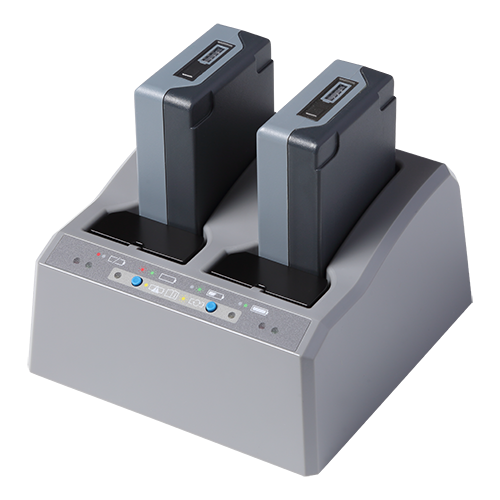Step 1. Charge the battery

The rechargeable Lithium-ion battery is supplied partially charged. Before using the battery for the first time, charge it completely using the dual slot battery charger and country-specific power supply and power cord.
The battery has built-in charge indicator LEDs. Push the button on the battery to check the battery charge status.
Charging takes approximately 3 hours at room temperature. If two batteries are charging in the dual battery charger, the batteries will be charged simultaneously.
Before operating the dual slot battery charger, review the safety notes and operating instructions in the Trimble Dual Slot Battery Charger (P/N 109000 User Guide.
Charging the battery
Ensure that nothing obstructs the vents in the back of the charger.
Charge the battery completely before using it for the first time.
-
To charge the battery, only use a charger that is recommended by Trimble for charging the Lithium-ion batteries.
-
Charge the battery before using the equipment if it has been stored for longer than six months.
The charger operates between 0 °C (32 °F) and 40 °C (104 °F). Charging a battery at temperatures in the range of 0 °C (32 °F) to 5 °C (41 °F) will take longer than charging at room temperature.
To charge the battery:
-
Ensure that the vents in the back of the charger are unobstructed.
-
Place the charger on a hard, flat and level surface, to ensure that there is sufficient airflow around the charger.
-
To apply power to the charger, use the AC to DC power converter or 12 V car battery adapter. The red LEDs light up when no batteries are inserted to the battery slots. The charger automatically scans the battery slots for a battery.
-
Place the battery in any of the slots. It can take up to five seconds to detect the battery. For an explanation of the LED display, see LED status indicators.
Leave a deeply discharged or shorted battery overnight in the charger to attempt to revive the battery. A shorted battery is typically revived as soon as the slot is scanned. If the red LED turns off, the battery is revived. If the red LED stays on, the battery is no longer functional and needs to be replaced.
LED status indicators
Beside each slot are three LED indicators (red, green, and yellow) to display the battery status. The LED indicators can have the following conditions: Off, On, 1 Hz (one flash per second), and 2 Hz (two flashes per second).

|
Status |
Red LED |
Green LED |
Yellow LED |
|---|---|---|---|
|
No battery detected (means no battery present or battery defect) |
ON |
OFF |
OFF |
|
Battery detected (charging not started yet)
|
1 Hz 1 Hz |
1 Hz 1 Hz |
OFF ON |
|
Charging in progress
|
OFF OFF 2 Hz |
1 Hz 1 Hz OFF |
OFF ON OFF |
|
Conditioning in progress |
ON |
OFF |
1 Hz |
|
Conditioning done (Charging after 30% battery capacity) |
ON |
1 Hz |
OFF |
|
Conditioning done (Battery fully charged) |
ON |
ON |
OFF |
|
Battery fully charged
|
OFF OFF |
ON ON |
OFF ON |
|
Power supply over/under-voltage |
OFF |
OFF |
OFF |
|
When Output Over-Voltage Protection (OOVP) or Output Over Current Protection (OCP) is on |
2 Hz |
OFF |
OFF |
Battery life
You should expect the battery to take 300 charges. Some batteries may last up to 500 charges. The battery life will decrease over time as the battery is used more, especially if the batteries are used in hot areas or in high current situations, like a base station.
It will not harm the battery if it is half used before you place it in the charger. You do not need to drain the battery fully. However, charging a half-used battery still counts toward the number of expected battery chargers over the life of the battery.
There is no memory build up with these batteries. Trimble recommends that you store the battery when it is fully charged. Batteries may experience a 5 to 20% discharge per month when they are not being used. If the battery is stored for weeks at a time fully discharged, a significant loss of charging capacity could occur.
Temperature considerations
In general, you will see a decrease in battery runtime if the batteries are used in colder temperatures. Higher temperatures are better for battery operation as long as the temperature does not exceed 40 °C (104 °F). If operating in less than 5 °C (41 °F), there will be significant decrease in battery runtime. If the battery has been stored at less than 5 °C (41 °F), it may not work at all until it is stored at room temperature (20 °C to 25 °C (68 °F to 77 °F). Batteries should not be used if temperatures are below -20 °C (-4 °F) or above 50 °C (122 °F).